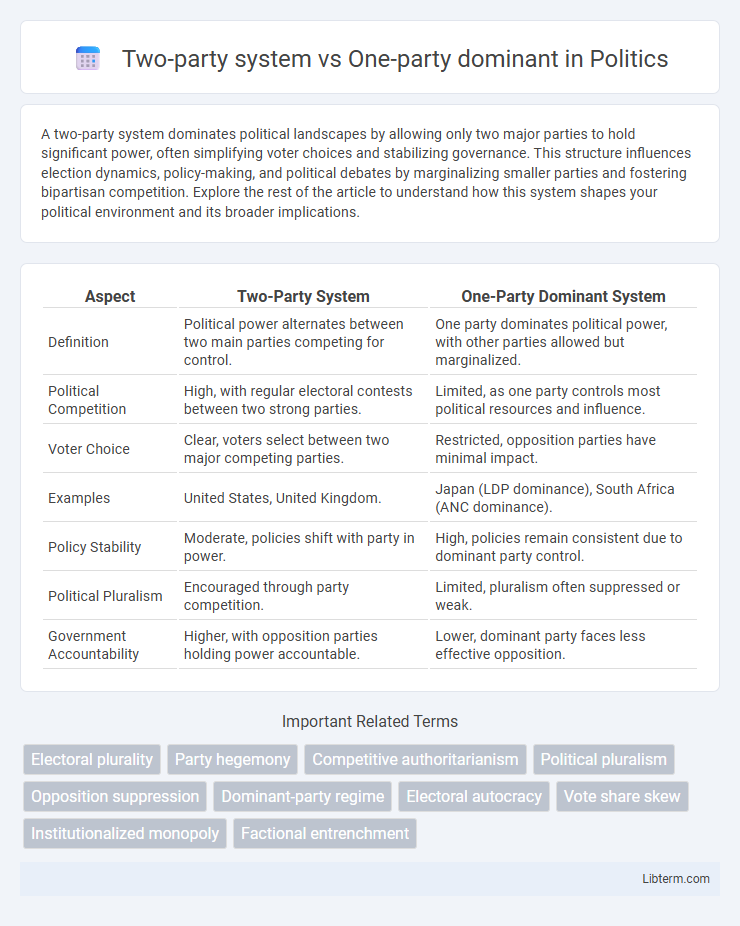A two-party system dominates political landscapes by allowing only two major parties to hold significant power, often simplifying voter choices and stabilizing governance. This structure influences election dynamics, policy-making, and political debates by marginalizing smaller parties and fostering bipartisan competition. Explore the rest of the article to understand how this system shapes your political environment and its broader implications.
Table of Comparison
| Aspect | Two-Party System | One-Party Dominant System |
|---|---|---|
| Definition | Political power alternates between two main parties competing for control. | One party dominates political power, with other parties allowed but marginalized. |
| Political Competition | High, with regular electoral contests between two strong parties. | Limited, as one party controls most political resources and influence. |
| Voter Choice | Clear, voters select between two major competing parties. | Restricted, opposition parties have minimal impact. |
| Examples | United States, United Kingdom. | Japan (LDP dominance), South Africa (ANC dominance). |
| Policy Stability | Moderate, policies shift with party in power. | High, policies remain consistent due to dominant party control. |
| Political Pluralism | Encouraged through party competition. | Limited, pluralism often suppressed or weak. |
| Government Accountability | Higher, with opposition parties holding power accountable. | Lower, dominant party faces less effective opposition. |
Defining Two-Party and One-Party Dominant Systems
A two-party system features two major political parties competing for control of government, often resulting in a clear majority and a balanced political landscape. One-party dominant systems are characterized by a single political party maintaining continuous control over governance, despite the presence of other parties. The two-party model promotes competitive elections, while one-party dominance often limits political pluralism and power shifts.
Historical Origins of Party Systems
The historical origins of two-party systems often stem from constitutional frameworks and electoral rules such as single-member district plurality voting, which encourages competition between two major parties, exemplified by the United States and the United Kingdom. One-party dominant systems typically arise from colonial legacies, post-colonial state-building, or authoritarian regimes where a single party maintains control through institutional mechanisms, as seen in countries like South Africa with the African National Congress. Understanding these origins reveals how historical, social, and legal factors shape the structure and persistence of party systems worldwide.
Core Features of a Two-Party System
A two-party system is characterized by the dominance of two major political parties that compete for control of government, creating a stable and clear-cut electoral choice for voters. This system encourages coalition-building within the parties, leading to moderate policies that appeal to a broad electorate. Voters typically align themselves with one of the two parties, increasing political accountability and fostering a direct connection between constituents and their representatives.
Key Characteristics of One-Party Dominance
One-party dominant systems are characterized by the continuous control of a single political party that dominates elections and governance without formally banning opposition parties. This dominance often results from mechanisms such as state resources being used to support the ruling party, media control, and limitations on competition within the political arena. The key features include restricted political pluralism, reduced electoral competitiveness, and the dominance of party elites over policy-making processes.
Political Competition: Pluralism vs Monopolization
In a two-party system, political competition thrives through pluralism, where multiple parties actively contest power, ensuring diverse viewpoints and voter engagement. In contrast, a one-party dominant system monopolizes political authority, limiting genuine competition and often suppressing opposition, which undermines democratic processes. This monopolization stifles policy innovation and reduces accountability, concentrating power within a single party apparatus.
Governance Efficiency and Policy Stability
A two-party system often enhances governance efficiency by promoting clear majority rule and streamlined decision-making, reducing legislative gridlock through competitive electoral processes. In contrast, a one-party dominant system can achieve policy stability by maintaining consistent governance and minimizing policy fluctuations, though it may face challenges regarding accountability and responsiveness. Both systems impact governance differently: two-party systems encourage adaptability and debate, while one-party dominance ensures long-term policy continuity.
Representation and Voter Choice
A two-party system offers clearer voter choice by providing distinct political alternatives, enhancing representation through competition and accountability between parties. In contrast, a one-party dominant system limits voter choice as political power is concentrated within a single party, often restricting genuine opposition and reducing the effectiveness of representation. This concentration can lead to voter apathy and weaker democratic responsiveness due to limited electoral competition.
Risks of Polarization and Authoritarianism
A two-party system often intensifies political polarization by narrowing voter choices and deepening ideological divides, which can hinder bipartisan cooperation and effective governance. In contrast, a one-party dominant system risks authoritarianism as prolonged single-party rule can erode democratic checks and balances, suppress opposition, and concentrate power. Both systems pose challenges: the two-party model may escalate societal conflicts, while the one-party dominant model threatens political pluralism and the protection of civil liberties.
Case Studies: Examples Around the World
The United States exemplifies a stable two-party system dominated by the Democratic and Republican parties, fostering competitive elections and policy shifts. In contrast, South Africa represents a one-party dominant system where the African National Congress has maintained political control since the end of apartheid, limiting opposition influence. Similarly, Mexico's political landscape transitioned from one-party dominance under the Institutional Revolutionary Party to a more pluralistic system, illustrating the dynamic nature of party systems in global case studies.
Future Trends in Political Party Systems
The future of political party systems reveals a complex interplay between two-party systems and one-party dominant models, with emerging trends toward greater political polarization and digital campaigning reshaping voter engagement. Technological advancements and social media platforms increasingly influence party strategies, potentially challenging traditional two-party dominance by enabling smaller parties to mobilize niche voter bases. Global shifts toward authoritarianism in some regions underscore the persistence of one-party dominant systems, while democratic innovations may foster multiparty competition and reduce political monopolies.
Two-party system Infographic

 libterm.com
libterm.com